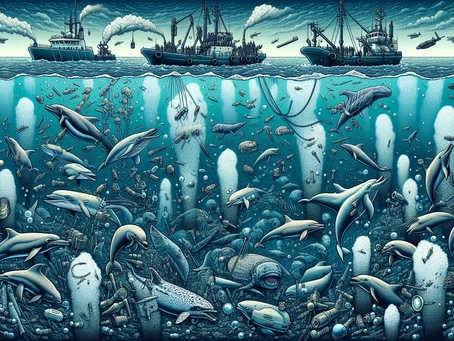Ocean Noise Pollution: An Invisible Threat
Ocean noise pollution is an escalating problem that poses a significant threat to marine ecosystems. Marine mammals, in particular, are vulnerable as they rely heavily on sound for communication, navigation, and foraging. The rise of human activity in the oceans has turned a once-balanced soundscape into an increasingly hostile environment. Addressing this issue is essential for preserving biodiversity and ensuring the health of our seas.
What Counts as Ocean Noise Pollution?
Defining the Problem
Ocean noise pollution refers to disruptive sounds introduced into the marine environment by human activity. Unlike natural sounds such as waves, rain, or animal calls, anthropogenic noise stems from ship engines, seismic surveys, sonar, and underwater construction. While the ocean has always been alive with sound, the scale and intensity of human-made noise are tipping the balance against marine life.
Sources of Noise
- Shipping traffic: Constant low-frequency hum from global trade routes.
- Seismic surveys: Loud blasts used in oil and gas exploration.
- Sonar: Military and commercial sonar that travels vast distances.
- Construction: Pile driving, dredging, and offshore drilling.
Together, these activities create a persistent acoustic smog that reaches far beyond local areas.
How Sound Travels Underwater
Sound moves faster and farther in water than in air, traveling about 1,500 meters per second. Its transmission is influenced by temperature, salinity, and depth, allowing sound to carry over great distances. For marine mammals, this property enables long-range communication but also magnifies the reach of harmful noise pollution.
Marine Mammals and the Language of Sound
Communication and Social Bonds
Dolphins, whales, and other marine mammals rely on clicks, whistles, and songs to communicate, coordinate hunts, and attract mates. Disrupting these vocalizations can weaken social bonds and reproductive success.
Echolocation: Nature’s Sonar
Many marine mammals use echolocation to navigate and hunt in dark waters. They emit high-frequency sounds that bounce back as echoes, creating mental maps of their environment. When noise pollution interferes, it undermines this critical survival tool.
The Effects of Noise Pollution
Stress and Health Issues
- Chronic stress from loud noise raises hormone levels and weakens immunity.
- Long-term exposure can impair reproduction and reduce survival rates.
- Excessive noise may even cause hearing loss, a life-threatening condition for sound-dependent animals.
Disrupted Feeding and Breeding
Noise can mask prey sounds, making hunting inefficient, and drown out mating calls, leading to reduced reproduction. Over time, these disruptions threaten population stability.
The Human Contribution
Shipping
Vast shipping fleets generate low-frequency noise overlapping with whale communication ranges. As maritime trade expands, so does its acoustic footprint.
Oil Exploration and Construction
Seismic airguns and offshore drilling introduce deafening blasts that disorient marine mammals. Construction activities such as pile driving add further disruption to habitats already under strain.
Monitoring and Measuring the Ocean’s Soundscape
Scientists use hydrophones and autonomous recording units to capture and analyze underwater noise. These tools reveal how different species react to changing soundscapes and help identify critical thresholds for marine health.
Turning Down the Volume
Policy and Regulation
International treaties and national laws are being updated to include ocean noise reduction as part of marine conservation. Speed restrictions for ships and limits on seismic surveys are key steps forward.
Quieter Technology
- Electric propulsion reduces ship engine noise.
- Redesigned propellers limit cavitation.
- Improved hull shapes reduce turbulence and sound output.
Community and Global Initiatives
Local conservation groups, educational programs, and international collaborations all play a role in raising awareness and pushing for quieter oceans.
Broader Impacts of Noise Pollution
Beyond harming marine mammals, noise pollution disrupts entire ecosystems. Plankton, fish, and invertebrates are also affected, reducing biodiversity and weakening the food chain. These shifts can even influence carbon cycles, linking ocean noise indirectly to climate change. The ripple effects extend to global food security and coastal economies dependent on healthy seas.
Conclusion
Ocean noise pollution is more than an environmental nuisance—it is a growing crisis with far-reaching consequences. By adopting smarter policies, advancing quieter technologies, and supporting community-driven efforts, we can restore balance to the ocean’s acoustic environment. Protecting the soundscape is essential not just for whales and dolphins, but for the health of our entire planet.

